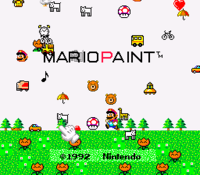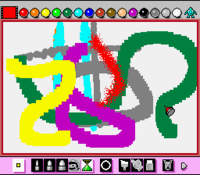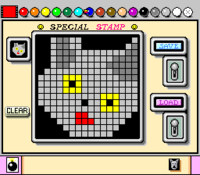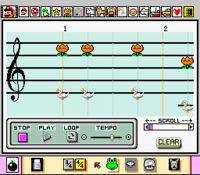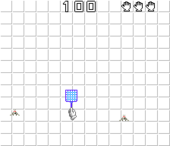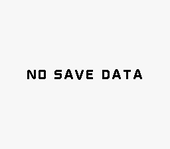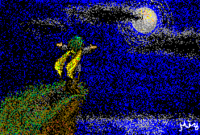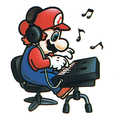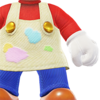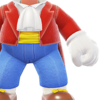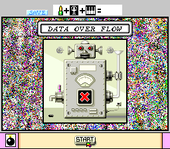Mario Paint: Difference between revisions
Technetium (talk | contribs) m (→Title screen) |
m (Text replacement - "{{([Ss]erials|[Rr]elease)\|" to "{{flag list|") |
||
| (4 intermediate revisions by 4 users not shown) | |||
| Line 6: | Line 6: | ||
|publisher=[[Nintendo]] | |publisher=[[Nintendo]] | ||
|designer=[[Hirofumi Matsuoka]] | |designer=[[Hirofumi Matsuoka]] | ||
|release={{ | |release={{flag list|Japan|July 14, 1992|USA|August 1, 1992|Europe|December 10, 1992<ref>{{cite|url=themushroomkingdom.net/games/mpaint|title=''Mario Paint''|publisher=The Mushroom Kingdom|language=en|accessdate=June 27, 2024}}</ref>}} | ||
|languages={{languages|en_us=y}} | |languages={{languages|en_us=y}} | ||
|genre=Miscellaneous | |genre=Miscellaneous | ||
| Line 14: | Line 14: | ||
|input={{input|snesmouse=1}} | |input={{input|snesmouse=1}} | ||
|format={{format|snes=1}} | |format={{format|snes=1}} | ||
|serials=SHVC-MSA | |serials={{flag list|Japan|SHVC-MSA}} | ||
}} | }} | ||
'''''Mario Paint''''' is a title on the [[Super Nintendo Entertainment System]]. It was originally bundled with the [[Super Nintendo Entertainment System#Super NES Mouse|Super NES Mouse]] accessory and was one of the few games to support it. The game received a [[Player's Choice]] reissue. | '''''Mario Paint''''' is a title on the [[Super Nintendo Entertainment System]]. It was originally bundled with the [[Super Nintendo Entertainment System#Super NES Mouse|Super NES Mouse]] accessory and was one of the few games to support it. The game received a [[Player's Choice]] reissue. | ||
| Line 132: | Line 132: | ||
The music mode has become a viral hit and many song compositions can be found on YouTube and other gaming sites. The Music Mode was recreated as a fan-made Windows program called ''Mario Paint Composer'' and added several features such as longer song length, more notes per beat, more sounds, and the ability to save. This program lacks the jumping Mario which was shown when a song is played. | The music mode has become a viral hit and many song compositions can be found on YouTube and other gaming sites. The Music Mode was recreated as a fan-made Windows program called ''Mario Paint Composer'' and added several features such as longer song length, more notes per beat, more sounds, and the ability to save. This program lacks the jumping Mario which was shown when a song is played. | ||
Instead of being delivered in Flash format like the rest of the series, the first episode of {{wp|Homestar Runner}} was animated using ''Mario Paint''. A primitive introduction video made with ''Mario Paint'' can be found in the museum of the site. A later short in the series, ''Strong Bad is a Bad Guy'', was made using ''Mario Paint''. | Instead of being delivered in Flash format like the rest of the series, the first episode of ''{{wp|Homestar Runner}}'' was animated using ''Mario Paint''. A primitive introduction video made with ''Mario Paint'' can be found in the museum of the site. A later short in the series, ''Strong Bad is a Bad Guy'', was made using ''Mario Paint''. | ||
==Promotion== | ==Promotion== | ||
| Line 143: | Line 143: | ||
''Mario Paint'' was re-released in two minor variations on the [[Satellaview]]: | ''Mario Paint'' was re-released in two minor variations on the [[Satellaview]]: | ||
*'''Mario Paint BS Ban''' ('''マリオペイントBS版''') is a version of ''Mario Paint'' which had joypad support. For this release of the game, a ''Mario Paint'' contest was held, in which contestants of exceptional ''Mario Paint'' artistic skill made artwork pieces.<ref>{{cite|language=ja|url=www.ncn-t.net/yulil/satella/drama/vol1.htm|title=Vol.1 南国に生まれた絵|publisher=www.ncn-t.net|accessdate=June 27, 2024}}</ref> This contest was held in November 1997.<ref>{{cite|deadlink=y|language=ja|archive=web.archive.org/web/20160308114645/http://www.f3.dion.ne.jp/%7Ekameb/satella/st_kbn/st_kbn7b.htm|title=Satellaview History Museum|publisher=www.dion.ne.jp|accessdate=June 27, 2024}}</ref> | *'''Mario Paint BS Ban''' ('''マリオペイントBS版''') is a version of ''Mario Paint'' which had joypad support. For this release of the game, a ''Mario Paint'' contest was held, in which contestants of exceptional ''Mario Paint'' artistic skill made artwork pieces.<ref>{{cite|language=ja|url=www.ncn-t.net/yulil/satella/drama/vol1.htm|title=Vol.1 南国に生まれた絵|publisher=www.ncn-t.net|accessdate=June 27, 2024}}</ref> This contest was held in November 1997.<ref>{{cite|deadlink=y|language=ja|archive=web.archive.org/web/20160308114645/http://www.f3.dion.ne.jp/%7Ekameb/satella/st_kbn/st_kbn7b.htm|title=Satellaview History Museum|publisher=www.dion.ne.jp|accessdate=June 27, 2024}}</ref> | ||
*'''Mario Paint | *'''Mario Paint Yūshō Naizō Ban''' ('''マリオペイント優勝内蔵版''') is similar to ''Mario Paint BS Ban'', but it also has a hidden picture - identified as "Dreaming of the Moon" ('''「月を夢見て」''') by Mizota Hiroko ('''溝田 祐子''') from the ''Mario Paint'' contest - which can be found by using the "Load" option in "Save/Load/Coloring Book". | ||
{{br}} | {{br}} | ||
| Line 209: | Line 209: | ||
|JapM=Mario Paint | |JapM=Mario Paint | ||
|ChiS=马力欧画画 | |ChiS=马力欧画画 | ||
|ChiSN=''WarioWare, Inc.: Mega Microgame$!''<br>''WarioWare: Touched!'' | |||
|ChiSR=Mǎlì'ōu Huàhuà | |ChiSR=Mǎlì'ōu Huàhuà | ||
|ChiSM=Mario Paint | |ChiSM=Mario Paint | ||
Latest revision as of 20:07, September 27, 2024
- This article is about the game Mario Paint. For the WarioWare: Touched! microgame based on the game, see Mario Paint (WarioWare: Touched!). For the WarioWare: D.I.Y. microgame based on the game, see Mario Paint (WarioWare: D.I.Y.).
| Mario Paint | |||
|---|---|---|---|
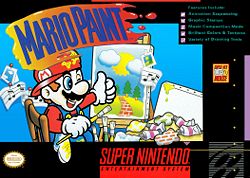 For alternate box art, see the game's gallery. | |||
| Developer | Nintendo R&D1 Intelligent Systems[1] | ||
| Publisher | Nintendo | ||
| Platform(s) | Super Famicom/Super Nintendo Entertainment System | ||
| Release date | |||
| Language(s) | English (United States) | ||
| Genre | Miscellaneous | ||
| Rating(s) |
| ||
| Mode(s) | Single player | ||
| Format | Super NES: | ||
| Input | Super NES:
| ||
| Serial code(s) | |||
Mario Paint is a title on the Super Nintendo Entertainment System. It was originally bundled with the Super NES Mouse accessory and was one of the few games to support it. The game received a Player's Choice reissue.
Title screen[edit]
The title screen is notable for being highly interactive - each letter causes a different effect on the game title screen.
- M - Shrinks Mario. If clicked again, returns him to normal size. Similar to the effects of getting hit or gaining a Super Mushroom.
- A - The letter A will fall down through the screen, and then go back to its place. If Mario is under the A when it falls, he will be knocked off-screen along with it, and also come back.
- R - An eye will appear on the R, and it makes a baby noise, and crawls off and back on screen. It makes the noise again. If the noise is played backwards, it sounds like a voice saying, "Nintendo", and slowing it down makes it sound like the original voice saying it.[3]
- I - Causes all black and white colors on screen to invert, including those on Mario. Also causes the title music to become distorted.
- O - O grows a fuse and explodes like a bomb. After this, Kazumi Totaka's famous song plays. (Totaka is famous for hiding this song in almost every game he has worked on; it has gone on to be included in Super Mario games such as Yoshi's Story, Luigi's Mansion, and Yoshi Touch & Go.)
- P - Replaces the title setting with a green field with trees, cars, animals, UFOs, shooting stars, and other moving objects, most of which make a sound when clicked. Clicking P again returns the title to normal. The music changes during this sequence, to a slower version of BGM 1 from the main game.
- A - Yoshi runs across the screen, along with drum sound effects while he is visible.
- I - All text on screen begins shaking, and the music is distorted.
- N - Credits appear onscreen. The music continues, but is accompanied by some extra background instruments not normally audible. If the game is started when the programmer is credited while the player is holding down the right mouse button, the following bonus features will be available:
- Right-clicking on the canvas in Art Mode or on the music score in Music Mode will remotely activate Undodog.
- Right-clicking on the canvas in Stamp Mode will select the color of the pixel under the cursor.
- Four more rotation options for stamps will become available: 90° counter-clockwise, 90° clockwise, 90° clockwise flipped horizontally and 90° counter-clockwise flipped horizontally.
- Ability to reset the game quickly by pressing
+
+
+
on a SNES Controller plugged into the second player port. The player would have to re-enable these features again upon reset.
- T - The player can draw using a rainbow texture with a thick crayon. The title music slows down, but keeps playing.
- Clicking on Mario will start the main game.
- Clicking on a falling Star after clicking on P will cause several objects to rain down the screen. The music will then change to harp music.
Play Modes[edit]
Art mode[edit]
The open canvas is the main part of the game. Here the player can draw with three sizes of pencil tools, paint, and use preexisting sprites (called "Stamps" by the game) of things from basic houses and trees to sprites directly from Super Mario World. The player can cycle through all the different colors and stamps offered by the game by clicking on Mr. Crayon. Additionally, the player can use a straight line tool, and add numbers and letters from a text menu. Erasing images can be done with a traditional erase tool, as well as several amusing screen transitions which wipe the screen clean. There is also an option to completely fill the screen with a certain color, texture, or sprite. To undo an action, the player has to select Undodog's icon.
Stamp mode[edit]
In addition to the default stamps, the game has room to save 15 custom sprites at any given time, which can be made in the Stamp menu. The player is given a grid and can create sprites pixel by pixel using a variety of colors. If a single pixel wide stamp is created it can be used as a pen that is much thinner than the one the game normally allows the player to use.
Music mode[edit]
In addition to creating visual works of art, the player can also create their own songs in Music Mode. Using a set of stamp icons to represent different instruments, they can be placed along a music score, creating a melody. Songs can be written in 3/4 or 4/4 time. The game has three default songs: an arrangement of Super Mario Bros.'s Ground Theme and Super Mario World's Ground Theme theme by Koji Kondo, an arrangement of Twinkle, Twinkle, Little Star, and an arrangement of the song used in the Japanese commercial for Mario Paint. The songs created here can be used in Animation Mode. Undodog also appears in this mode helping players undo previous actions.
Instruments[edit]
- Mario - Kalimba
- Super Mushroom - Drum
- Fire Flower - Trumpet
- Super Star - Xylophone
- Baby Yoshi - Yoshi sound effect from Super Mario World
- Game Boy - Square wave
- Dog - Woof
- Cat - Meow
- Pig - Grunt
- Baby Face - Baby sound
- Ship - Different drum
- Airplane - Acoustic guitar
- Heart - Bass guitar
- Swan - Orchestra hit
- Car - Organ
Animation mode[edit]
The player can create their own looping animation, frame by frame with a frame limit, and then set them into motion on top of the background they have displayed in their main canvas. Additionally, if they so choose, their animation can be accompanied by their selected song in Music Mode.
Gnat Attack[edit]
- Main article: Gnat Attack
Gnat Attack is not an art creation section, but rather a minigame in which the player must use the Super NES Mouse to swat different fly-like enemies. Completing stages causes Super Mario characters to walk across the screen.
This game was also a microgame and minigame in WarioWare, Inc.: Mega Microgame$!. It can be accessed by clicking the toolbar arrow on the bottom bar, and then, in the same bar, clicking the coffee cup icon. The game also appears as one of 9-Volt's microgames in WarioWare: D.I.Y. and later as a microgame in Gamer from Game & Wario, under the name "Super Fly Swatter". It also can be found in Super Mario Maker as a minigame in the editor, unlocked by shaking a Muncher several times.
Other features[edit]
- BGM Setting - The player can choose one of three background songs (or no music) to accompany them as they draw and paint. If the music is turned off, the sound of Undodog sneezing occasionally plays.
- Mouse Speed - Choose between Slow, Medium, and Fast.
- Save/Load/Coloring Book - The game can save one canvas at any given time, and it can be brought back up using the Load option. These sequences are accompanied by the image of a robot processing data with techno music. Coloring Book has four default black and white saved canvases that can be quickly loaded onto the screen.
- Frame - Simply gets rid of the upper and lower menu option icons, and replaces them with a black frame. Clicking the option again goes back to normal mode.
- Quick Start - Pressing
+
+
on a SNES Controller plugged into the second player port allows the player to instantly start the game.
- View Save Data - Pressing
+
+
on a SNES Controller plugged into the second player port allows the player to view the most recently saved image, animation and song. If there is nothing saved to the file, it displays "NO SAVE DATA" instead.
Reception[edit]
Mario Paint was rated the 162nd best game made on a Nintendo System in Nintendo Power's Top 200 Games list.
| Reviews | |||
|---|---|---|---|
| Release | Reviewer, Publication | Score | Comment |
| SNES | Nintendo Power[4] | N/A | George — "While Mario Paint might seem like a real special interest program, it's so well made that I think that anyone who has even a remote interest in creating drawings, animation or music will really like it" Rob — "I think that this program is really cool and will be a blast for people of any age." |
| SNES | Ed Semrad, Electronic Gaming Monthly[5] | 8/10 | "Nintendo has always strived to introduce accessories and enhancements to their systems and this time it's a mouse peripheral and pad. This device simulates the feel of an artistic tool and allows anyone the ability to design their own masterpieces. Coupled with an animation and sound studio, this cart is a solid hit!" |
| SNES | N. Somniac, GamePro[6] | Graphics: 5.0/5.0 | "Although accessible to players of any ability, Mario Paint's cheerful demeanor and whimsical icon-driven format indicate that it's primarily geared towards a younger audience. The SNES mouse and its user-friendly options make this the perfect introduction for kids to computers. However, there's definitely enough interaction, complexity, and options to keep older gamers just as interested. A nice change of pace from other SNES fare. Mario Paint's a work of art!" |
| Sound: 4.5/5.0 | |||
| Controls: 5.0/5.0 | |||
| Fun factor: 4.5/5.0 | |||
Legacy[edit]
Prominent video game developers have cited Mario Paint as an inspiration. Masahito Hatakeyama, one of the designers for WarioWare: D.I.Y., cites Mario Paint's drawing and music creation tools as inspiration for the drawing and music creation tools in D.I.Y., while several staff members of the development team cited it as the game that taught them the joy of developing video games.[7] One of the sound staff from Mario Paint, Hirokazu Tanaka, later went on to work on EarthBound. Some of Mario Paint's sound effects and musical instruments were used in both games.
The music mode has become a viral hit and many song compositions can be found on YouTube and other gaming sites. The Music Mode was recreated as a fan-made Windows program called Mario Paint Composer and added several features such as longer song length, more notes per beat, more sounds, and the ability to save. This program lacks the jumping Mario which was shown when a song is played.
Instead of being delivered in Flash format like the rest of the series, the first episode of Homestar Runner was animated using Mario Paint. A primitive introduction video made with Mario Paint can be found in the museum of the site. A later short in the series, Strong Bad is a Bad Guy, was made using Mario Paint.
Promotion[edit]
In Volume 41 of Nintendo Power, the "Mario Paint Contest" was held.[8] To enter, participants created an art piece using the game, recorded it onto a video tape, and sent the tape to Nintendo Power's PO box. The "most creative entries" by sixteen participants were to be shown in a future volume of the magazine. The grand prize winner received five SNES Game Paks while fifteen runner-ups received just one Game Pak. The contest ended on December 1, 1992. In Volume 47, the sixteen winners and their pieces were shown.[9] The grand prize was given to Stephen D. Miller from Tuscon, Arizona.
Satellaview versions[edit]
Mario Paint was re-released in two minor variations on the Satellaview:
- Mario Paint BS Ban (マリオペイントBS版) is a version of Mario Paint which had joypad support. For this release of the game, a Mario Paint contest was held, in which contestants of exceptional Mario Paint artistic skill made artwork pieces.[10] This contest was held in November 1997.[11]
- Mario Paint Yūshō Naizō Ban (マリオペイント優勝内蔵版) is similar to Mario Paint BS Ban, but it also has a hidden picture - identified as "Dreaming of the Moon" (「月を夢見て」) by Mizota Hiroko (溝田 祐子) from the Mario Paint contest - which can be found by using the "Load" option in "Save/Load/Coloring Book".
Staff[edit]
- Main article: List of Mario Paint staff
Gallery[edit]
- For this subject's image gallery, see Gallery:Mario Paint.
Artist Mario
Media[edit]
- For a complete list of media for this subject, see List of Mario Paint media.
| File info 0:30 |
| File info 0:09 |
| File info 0:30 |
| File info 0:29 |
References in later games[edit]
- Mario Artist: Polygon Studio: The "exercise" cutscene from Mario Paint is recreated in this game, and the two figures within it appear as helpful NPCs, with one of them being referred to as "the Baker". The Baby Face also occasionally appears in the background of the polygon viewer and makes its signature noise when clicked on.
- WarioWare, Inc.: Mega Microgame$!: The Baker appears in the third level difficulty of I Came, I Saw as the object inside the log. Additionally, the microgame Mario Paint: Fly Swatter and minigame Fly Swatter are based on Gnat Attack.
- WarioWare: Twisted!: The Baker appears as the object the player throws in the third level difficulty of Boomerang! and as the object inside of the apple in the third level difficulty of Red Delicious?.
- WarioWare: Touched!: A microgame based on Mario Paint appears in this game. The Turntable souvenir features an arrangement of the art mode background music, which is also used in the microgame. The Wario Paint souvenir is based on the game's art mode.
- Wii: In the Photo Channel's doodle mode, a recreation of the rocket ship erase animation is played when "Undo all" is selected.
- WarioWare: D.I.Y.: Another microgame based on Mario Paint appears in this game, as well as a record of the main theme. The Baker can appear in I Saw It! as the object inside the log. The Baby Face appears as a stamp in the Game MakerMatic mode of the Super MakerMatic 21 and in Boxed Up. Many elements in the game are also based on Mario Paint, such as when making a microgame.
- Game & Wario: Super Fly Swatter is based on Gnat Attack and winged Baby Faces can appear in the place of the regular flies. Baby Faces also appear in Wingbag.
- Super Mario Maker: Several features return from Mario Paint, such as Gnat Attack, the Undodog, and the interactive title screen. The Baby Face appears as a sound effect, and the Baker and his brother reappear in loading screens in Course World. A near-identical rendition of the Data Robot theme is used as the Coursebot theme.
- Super Smash Bros. for Wii U: An arranged medley of songs from Mario Paint can be played on the Miiverse stage in this game.
- Super Mario Odyssey: Multiple Crazy Cap costumes are based off of Mario's appearance in some pieces of Mario Paint artwork.
- WarioWare Gold: The Baby Face, along with its sound, makes several appearances.
- Super Mario Maker 2: The pig from Music Mode reappears as part of a sound effect. Additionally, the Baby Face sound effect returns from Super Mario Maker.
- WarioWare: Get It Together!: If a crew member has the Baby Face special skin applied, the baby noise from Mario Paint plays while its face appears whenever they talk.
- WarioWare: Move It!: The Baker and his brother can appear as drawings on the title screen.
Names in other languages[edit]
| Language | Name | Meaning | Notes |
|---|---|---|---|
| Japanese | マリオペイント[?] Mario Peinto |
Mario Paint | |
| Chinese (simplified) | 马力欧画画[?] Mǎlì'ōu Huàhuà |
Mario Paint | WarioWare, Inc.: Mega Microgame$! WarioWare: Touched! |
Trivia[edit]
- Upon starting the game, a short cartoon will play. This cartoon involves two primitively drawn characters, one of which is doing situps while the other holds his feet. The cartoon is almost entirely white save for the outlines of the characters, and takes place in an iris shot in an otherwise black background. During the cartoon, chanting can be heard, after which the chanters say "Mario Paint!" and an unseen audience yells "Whoa!" as the situp man does a handstand. On other times that the game is running, the audio will instead be cheering, accompanied at the end by a little fanfare.
- The game Mario Artist: Paint Studio was a direct sequel to Mario Paint at some point during production, titled Mario Paint 64. The game was later reworked into being the first title of its own series.
- If the player manages to fill up both canvases in Art and Animation Modes to cause the resulting work to become too large to compress down to fit into the cartridge's 32kb SRAM, attempting to save the work will cause it to fail and display the error "DATA OVER FLOW" along with a unique animation of smoke emitting from the sides of the robot's head. This can easily be replicated by using the spray tool with every color.[12]
References[edit]
- ^ ゲーム | INTELLIGENT SYSTEMS CO., LTD.. Intelligent Systems (Japanese). Retrieved June 27, 2024.
- ^ Mario Paint. The Mushroom Kingdom (English). Retrieved June 27, 2024.
- ^ Supper Mario Broth (September 14, 2022). On the title screen of Mario Paint, clicking the "R" plays a sound. That sound is actually a voice saying "Odnetnin", or "Nintendo" backwards. The footage below first plays the clip normally, then reverses it, and finally slows it down to hear the original "Nintendo" voice.. Twitter (English). Retrieved June 27, 2024.
- ^ August 1992. Nintendo Power Volume 39. Nintendo of America (American English). Page 104.
- ^ October 1992. Electronic Gaming Monthly Volume 5, Issue 10. Page 24.
- ^ January 1993. GamePro issue 42. Page 90.
- ^ Iwata Asks | 1. It Started Over Five Years Ago | Iwata Asks - WarioWare D.I.Y. | Nintendo. Nintendo of UK (British English). Retrieved June 27, 2024.
- ^ October 1992. Nintendo Power Volume 41. Nintendo of America (American English). Page 115.
- ^ April 1993. Nintendo Power Volume 47. Nintendo of America (American English). Page 117.
- ^ Vol.1 南国に生まれた絵. www.ncn-t.net (Japanese). Retrieved June 27, 2024.
- ^ Satellaview History Museum. www.dion.ne.jp (Japanese). Archived March 8, 2016, 11:46:45 UTC from the original via Wayback Machine. Retrieved June 27, 2024.
- ^ NovaSquirrel (December 17, 2020). Mario Paint "Data Over Flow" error. YouTube (English). Retrieved June 27, 2024.
| Mario Paint | ||
|---|---|---|
| Characters | Mario • Undodog • Mr. Crayon • Baker • Baby Face | |
| Gnat Attack | Big Fly • Fly • Fly Bomb • Fly Child • Fly Parent • King Watinga | |
| Other | Media • Staff • Gallery • Mario Artist series | |

